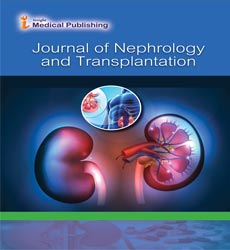Causes of Nephritis and its Treatment
Hissa Mohammed*
Department of Medicine, University of Hong Kong, Hong Kong, China
- *Corresponding Author:
- Hissa Mohammed
Department of Medicine,
University of Hong Kong,
Hong Kong,
China
E-mail: hasabi16@outlook.com
Received Date: December 06, 2021; Accepted Date: December 20, 2021; Published Date: December 27, 2021
Citation: Mohammed H (2021) Causes of Nephritis and its Treatment. J Nephrol Transplant Vol.5 No.5: e001.
Editorial Note
Nephritis is a disease in which the nephr on, the functio nal unit of the kidney, becomes inflamed. This inflammation, also known as glomerulonephritis, can affect renal function . T he kidney is a bean-shaped orga n tha t filte rs the blood a nd circulates in the body to remove excess water and waste products. There are different types of nephritis and differe nt causes of it. Some types appear suddenly, while others develop as part of a chronic condition and require continuous treatment.
What to Know About Nephritis?
Causes of nephritis
There are many causes of nephritis. The cause may not be clear. Nephritis and kidney disease appear to occur in the family, suggesting possible genetic components. Some infections, such as HIV and hepatitis B or C, can also cause of nephritis. In some cases, drugs such as antibiotics can cause kidney damage. This damage can lead to nephritis. Taking too many painkillers, Non Steroidal Anti-Inflammatory Drugs (NSAIDs), or diuretics can cause this condition. The two kidneys are bean-shaped, fist-sized organs located just below the ribs on either side of the spine. It removes impurities and excess water from the blood and filters about 150 litres of blood per day. Each kidney is made up of thousands of structures called nephrons, where blood is filtered. A two-step cleaning process separates necessary nutrients from waste products in each nephron. A filter called the glomerulus catches blood cells and protein, sending water and waste to a second filter called the tubule. The tubule captures minerals and extra protein. After that, waste materials leave the body in the urine. In people with nephritis, both the tubules and nearby tissues become inflamed, which can lead to kidney damage. Damaged kidneys are unable to function at full capacity. Waste builds up and causes serious health problems. If the condition is severe or persistent enough, it can result in kidney failure.
Symptoms of nephritis
Symptoms of pyelonephritis rarely become severe in the early stages. The following signs may indicate that a person is in early stage: changes in urinary habits, swelling of the hands, feet, ankles, face, changes in urine color, foamy urine, blood in the urine.
When to see a doctor?
Urine containing blood looks brown or pink. Seek medical attention as soon as possible if person have this symptom. It is also advisable to see a doctor for other symptoms related to urine. Early treatment can prevent permanent kidney damage and more serious complications of nephritis.
Treatment of nephritis
Treatment of pyelonephritis depends on the cause and type. Acute nephritis may be cured without treatment. However, it usually requires medication and special procedures to remove excess water and dangerous proteins. Treatment of chronic nephritis usually includes regular kidney tests and blood pressure monitoring. Doctors may prescribe water tablets to control blood pressure and reduce swelling. Drugs that prevent the immune system from attacking the kidneys may also be beneficial in some cases. Your doctor can also refer a person with a kidney infection to a nutritionist and give advice on what to eat to protect your kidneys. A proper diet is usually low in protein, salt, and potassium.
Prevention of nephritis
Although it is not always possible to prevent nephritis, certain lifestyle practises can reduce the risk for many. These practises also include maintaining a healthy weight, stopping smoking, maintaining blood pressure and blood sugar levels within healthy limits, regular exercise, and eating a nutritious and balanced diet. It helps to protect a person’s health.
Open Access Journals
- Aquaculture & Veterinary Science
- Chemistry & Chemical Sciences
- Clinical Sciences
- Engineering
- General Science
- Genetics & Molecular Biology
- Health Care & Nursing
- Immunology & Microbiology
- Materials Science
- Mathematics & Physics
- Medical Sciences
- Neurology & Psychiatry
- Oncology & Cancer Science
- Pharmaceutical Sciences
